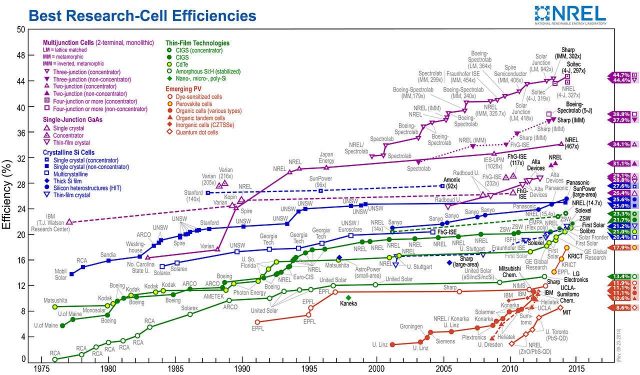Quantum Thermodynamics V: Photocells
Sunlight is the most important energy source of Earth. All earthlings live thanks to the ability of plants and bacteria to transform solar energy into chemical one. As sunlight is a free, and practically unlimited, energy source it is easy to understand the general interest in finding efficient ways of transforming it into electrical power. This interest has leaded to a very active research that has improved the efficiency of photovoltaic energy conversion dramatically in the last twenty years. In Figure 1 solar cells efficiency as a function of time for different technologies is displayed.

This improvement comes from many different approaches and by the use of different technologies. In this post we are going to discuss three new approaches that involve quantum effects as a resource to improve photocells efficiency.
- To use quantum coherence to reduce radiative recombination
The principal energy loss process in photovoltaics is called ‘radiative recombination’, and its nature comes from the same process that creates electric power from sunlight. To ilustrate this process we have included a figure from 1. Figure 2 (a) shows a schematic photocell composed of quantum dots sandwiched by semiconductors, and in Figure 1(b) we observe the energy diagram of one of these quantum dots. The main process of power production in these systems is based in the absorption of one photon that makes an electron to jump from the state labelled as |v> to the state |c>. This jump creates both a free (or quasifree) electron and a vacancy of an electron (what is called a ‘hole’). These free electrons and holes are responsible for the energy current. What happens then if an electron finds a hole before it escapes from the cell? In this case the electron and the hole recombines and they emit a new photon and the power of the photocell reduces. Is this process unavoidable? This question is still a matter of debate.
In a recent review about the physics of photovoltaics conversion 2 it is claimed: “That leaves radiative recombination as the major [energy loss] process. Can this be avoided? The answer is no. If a radiative upward transition to generate the excitation is allowed, its reversal, the radiative downward transition must be allowed as well” (citation taken from [1]). This argument is based in what in statistical physics is called ‘detailed balance’, meaning that a microscopic process should be equilibrated by its reverse.

Fortunately, a method to avoid detailed balance in photocells has been recently proposed [1]. By the application of microwaves to the system it is possible to potentiate one of the processes in comparison with its opposite (see Figure 3). This cancellation is based in quantum interference, that is a pure quantum effect. The proposal is only for a very concrete system, a single frequency photocell, that receives light of a very concrete color, but even if the model used is just a toy model it is enough to show that this process is not unavoidable, as it was considered before. More realistic models and real experiments are still to come.

- To delocalize quantum states.
The second method also relies in quantum interference to improve photocell efficiency, but it uses this property in a different way. Instead of using interference to avoid recombination it can be used to increase the transport of energy. This is the main idea of a recent paper published in Physical Review Letters 3. In this paper the authors propose a biologically inspired model that improves the energy transfer efficiency up to a 25% compared with pure classical transfer. This proposal is inspired by energy transfer in photosynthesis where delocalization of excitations have been recently shown (see Non-trivial biological quantum effects).).
The main idea of this model is sketched in Figure 4. In Figure 4 (a) the ussual framework is displayed. In this case there are two donors (D1 and D2) that can absorb and emit photons and also transmit an electron to an acceptor A. Sometimes, the donors decay before transferring the electron to the acceptor, and the energy is lost. By changing each donor by two strongly coupled molecules (Figure 4 c) the same excitation can delocalize, occupying both molecules at the same time. This single excitation in two sites can form two different states. One of this states (bright) can absorb the energy from the photons, but does not interact with the acceptor, the other state (dark) can interact only with the acceptor. By doing this, the system can be optimized both to interact with the light and also with the acceptor, increasing the efficiency of the system.

- Layering solar cells to absorb more radiation.
Fortunately, this problem and its potential solution has been already explain to the general public by one of the most important researchers in this field, Chris C. Phillips.
Both the problem, not being able to absorb all the sunlight spectrum, and the solution, to create layers with different absorption rates, are clear in the Youtube video. The reader interested in a more technical explanation can check 4.
References
- M.O Scully. Quantum Photocell: Using Quantum Coherence to Reduce Radiative Recombination and Increase Efficiency. Phys. Rev. Lett. 104, 207701 (2010). ↩
- P. Wurfel. Photovoltaic Principles and Organic Solar Cells. Chimia 61, 770 (2007). ↩
- C. Creatore, MA Parker, S Emmott, and AW Chin. Efficient Biologically Inspired Photocell Enhanced by Delocalized Quantum States. Phys. Rev. Lett. 111, 253601 (2013). ↩
- M. Yoshida, H. Amrania, DJ Farrel, B Browne, W Yoxall, NJ Ekins-Daukes, and CC Phillips. Progress Towward Realizing an intermediate Band Solar Cell -Sequential Absorption of Photons in a Quantum Well Solar Cell. IEEE J. Photovoltaics 4(2), 634 (2014). ↩
1 comment
[…] Hainbat ahalegin egiten ari dira zelula fotovoltaikoen eraginkortasuna lortzeko. Honen harira, Daniel Manzanok efektu kuantikoa darabilten hiru ikuspuntu aztertzen ditu: Quantum Thermodynamics V: Photocells. […]